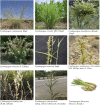Review of phytomedicine, phytochemistry, ethnopharmacology, toxicology, and pharmacological activities of Cymbopogon genus
- PMID: 36105217
- PMCID: PMC9465289
- DOI: 10.3389/fphar.2022.997918
Review of phytomedicine, phytochemistry, ethnopharmacology, toxicology, and pharmacological activities of Cymbopogon genus
Erratum in
-
Corrigendum: Review of phytomedicine, phytochemistry, ethnopharmacology, toxicology, and pharmacological activities of Cymbopogon genus.Front Pharmacol. 2022 Dec 7;13:1109233. doi: 10.3389/fphar.2022.1109233. eCollection 2022. Front Pharmacol. 2022. PMID: 36569298 Free PMC article.
Abstract
The Cymbopogon genus belongs to the Andropoganeae family of the family Poaceae, which is famous for its high essential oil concentration. Cymbopogon possesses a diverse set of characteristics that supports its applications in cosmetic, pharmaceuticals and phytotherapy. The purpose of this review is to summarize and connect the evidence supporting the use of phytotherapy, phytomedicine, phytochemistry, ethnopharmacology, toxicology, pharmacological activities, and quality control of the Cymbopogon species and their extracts. To ensure the successful completion of this review, data and studies relating to this review were strategically searched and obtained from scientific databases like PubMed, Google Scholar, ResearchGate, ScienceDirect, and Elsevier. Approximately 120 acceptable reviews, original research articles, and other observational studies were included and incorporated for further analysis. Studies showed that the genus Cymbopogon mainly contained flavonoids and phenolic compounds, which were the pivotal pharmacological active ingredients. When combined with the complex β-cyclodextrin, phytochemicals such as citronellal have been shown to have their own mechanism of action in inhibiting the descending pain pathway. Another mechanism of action described in this review is that of geraniol and citral phytochemicals, which have rose and lemon-like scents and can be exploited in soaps, detergents, mouthwash, cosmetics, and other products. Many other pharmacological effects, such as anti-protozoal, anti-bacterial, anti-inflammatory and anti-cancer have been discussed sequentially, along with how and which phytochemicals are responsible for the observed effect. Cymbopogon species have proven to be extremely valuable, with many applications. Its phytotherapy is proven to be due to its rich phytochemicals, obtained from different parts of the plant like leaves, roots, aerial parts, rhizomes, and even its essential oils. For herbs of Cymbopogon genus as a characteristic plant therapy, significant research is required to ensure their efficacy and safety for a variety of ailments.
Keywords: Cymbopogon; essential oils; pharmacological activity; phytochemistry; phytomedicine.
Copyright © 2022 Tibenda, Yi, Wang and Zhao.
Conflict of interest statement
The authors declare that the research was conducted in the absence of any commercial or financial relationships that could be construed as a potential conflict of interest.
Figures







References
-
- Ademuyiwa A. J., Elliot S. O., Olamide O. Y., Omoyemi A. A., Funmi O. S. (2015). The effects of Cymbopogon citratus (lemon grass) on the blood sugar level, lipid profiles and hormonal profiles of Wistar albino rats. Am. J. Toxicol. 1, 8–18.
Publication types
LinkOut - more resources
Full Text Sources

